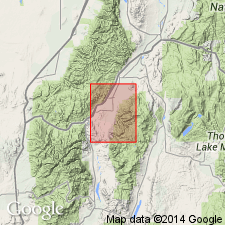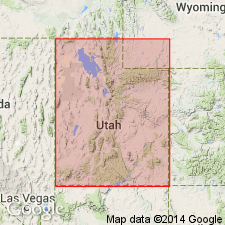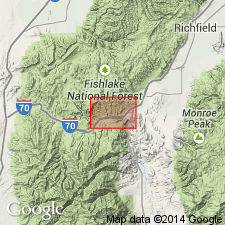
- Usage in publication:
-
- Joe Lott tuff*
- Modifications:
-
- Named
- Dominant lithology:
-
- Tuff
- AAPG geologic province:
-
- Wasatch uplift
Summary:
Named for a creek in northern part of area. Best exposures are in basin of Clear Creek west of Sevier, and in Beaver River basin southwest of Delano Peak. Small exposures occur in the Sevier-San Pitch Valley, north and south of Marysvale. All these areas occur on the Wasatch uplift in UT. No type locality designated. Is a white to light-yellow or brownish tuff. The lower part occurs in massive beds and has columnar structure. The upper part is interbedded with porphyritic latite and quartz latite flows of Dry Hollow latite. Overlain locally by an unnamed basalt. Assigned to the later Tertiary.
Source: GNU records (USGS DDS-6; Denver GNULEX).

- Usage in publication:
-
- Joe Lott tuff*
- Modifications:
-
- Age modified
- AAPG geologic province:
-
- Wasatch uplift
Summary:
Considered to be the youngest Pliocene? volcanic unit in quad. Formerly considered just Tertiary age. Reason for assignment to Pliocene? not stated. Exposures in quad lie in Sevier Co, UT on the Wasatch uplift. Is as much as 800 ft thick. Overlies Dry Hollow formation. Underlies locally the Sevier River formation. Detailed lithologic description.
Source: GNU records (USGS DDS-6; Denver GNULEX).

- Usage in publication:
-
- Joe Lott Tuff*
- Modifications:
-
- Age modified
- Areal extent
- AAPG geologic province:
-
- Wasatch uplift
- Paradox basin
Summary:
Age of Joe Lott Tuff modified from Pliocene? to Miocene. Age of Joe Lott is bracketed by radiometric ages obtained for the older Mount Belknap Rhyolite of middle Miocene and for some younger basalt flows of late Miocene age. Is present in small exposures in the southern Tushar Mountains, Piute Co, UT on the Wasatch uplift, and on the southern Sevier Plateau, Garfield Co, UT in the Paradox basin. Correlation chart; fence diagram; measured sections.
Source: GNU records (USGS DDS-6; Denver GNULEX).

- Usage in publication:
-
- Joe Lott Tuff Member*
- Modifications:
-
- Revised
- AAPG geologic province:
-
- Wasatch uplift
- Great Basin province
Summary:
Reduced in stratigraphic rank from Joe Lott Tuff to Joe Lott Tuff Member of Mount Belknap Volcanics. The type locality along Joe Lott Creek between 2.5 to 4.0 km south of Clear Creek, Sevier Co, UT on the Wasatch uplift has excellent exposures. Extends into Piute Co on the Wasatch uplift and into Beaver Co in the Great Basin province. Is part of the outflow facies of the Mount Belknap. Contains 1.4 percent phenocrysts including quartz, plagioclase, alkali feldspar, traces of biotite and accessory minerals in a groundmass of shards and pumice. Is 460 m at type. Is older than Red Hill Tuff Member (new) of Mount Belknap. Mount Belknap caldera, its source, collapsed as a result of these ash-flow eruptions about 19 m.y. ago or in Miocene time.
Source: GNU records (USGS DDS-6; Denver GNULEX).

- Usage in publication:
-
- Joe Lott Tuff Member*
- Modifications:
-
- Principal reference
- Geochronologic dating
- Dominant lithology:
-
- Rhyolite
- AAPG geologic province:
-
- Wasatch uplift
Summary:
Principal reference section designated in southern parts of T25S, Rs 4 1/2 and 5W along Clear Creek, Sevier Co, UT on the Wasatch uplift [Callaghan, 1939 did not declare intent to name nor did he designate a type locality]. Is a high silica, crystal-poor alkali rhyolite, a composite ash-flow sheet that changes laterally from a simple cooling unit near its source (Mount Belknap caldera) to four cooling units near its distal end. The four are designated lower, middle, pink, and upper cooling units; these are 64 m, 43 m, 26 m, and 31 m respectively, or they are 164 m thick along Clear Creek. The K-Ar age on the upper unit is 18.3 +/-1.1 m.y. on sanidine and 17.2 +/-0.7 on vitrophyre. Overlies crystal-rich tuff member; underlies Sevier River Formation. Is the largest (150 cubic km) rhyolite ash-flow sheet of the Marysvale volcanic field. Eruption of the lower unit led to the initial collapse of the Mount Belknap caldera.
Source: GNU records (USGS DDS-6; Denver GNULEX).
For more information, please contact Nancy Stamm, Geologic Names Committee Secretary.
Asterisk (*) indicates published by U.S. Geological Survey authors.
"No current usage" (†) implies that a name has been abandoned or has fallen into disuse. Former usage and, if known, replacement name given in parentheses ( ).
Slash (/) indicates name conflicts with nomenclatural guidelines (CSN, 1933; ACSN, 1961, 1970; NACSN, 1983, 2005, 2021). May be explained within brackets ([ ]).

